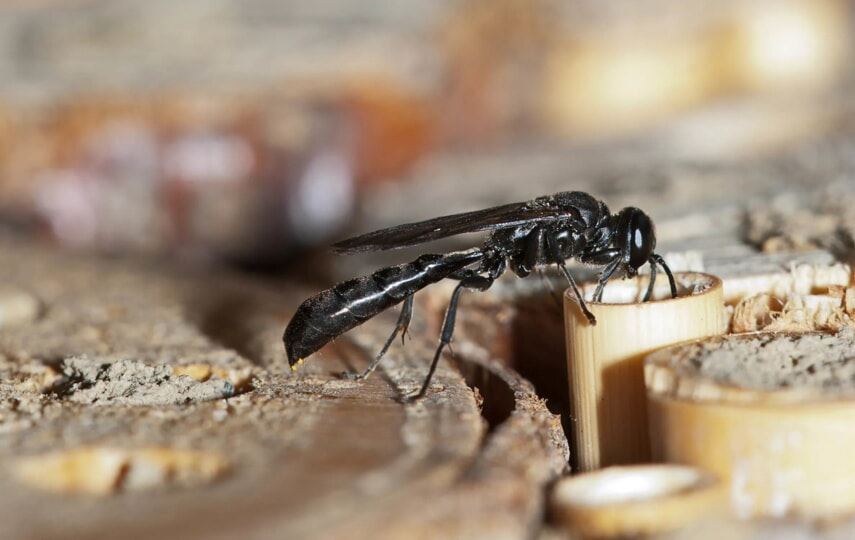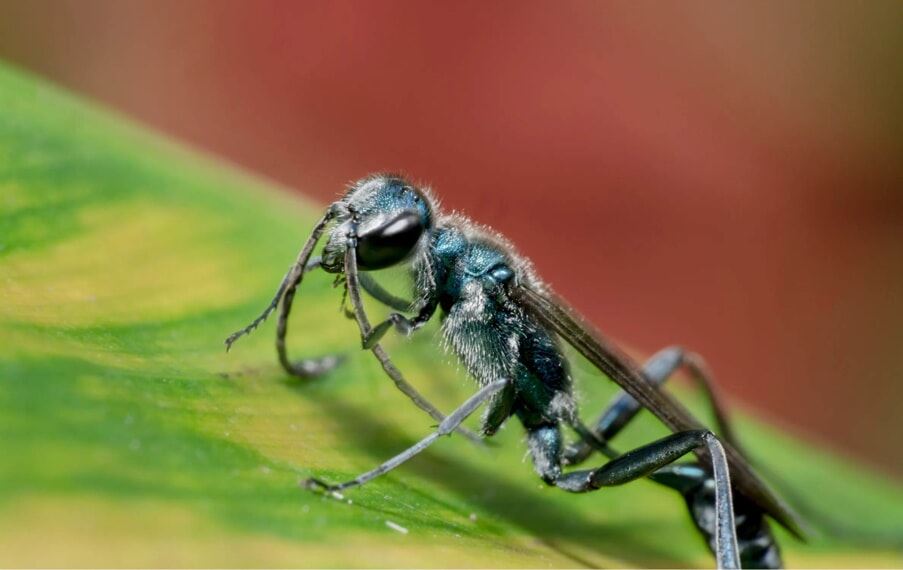What to Know About the Mud Dauber Wasp in Florida
Mud daubers in Florida build their mud homes everywhere—on buildings, under eaves, you name it.
Ever wonder why they pick these spots? Or what is a safe way to get rid of them?
Keep reading to learn more about the Mud Dauber wasp in Florida!
Key Takeaways
- Mud daubers in Florida are identifiable by their long, slender bodies, often black, metallic blue, or yellow, and they construct unique mud nests.
- Common Florida species include the black and yellow mud dauber, organ pipe mud dauber, blue mud dauber, and thread-waisted mud dauber, each with distinct behaviors and nesting habits.
- These solitary wasps build their nests in sheltered areas using mud and feed primarily on spiders, making them natural pest controllers.
- Signs of mud dauber presence include visible nests in sheltered locations and peak activity during warmer daylight hours in spring and summer.
- Preventing mud dauber infestations involves sealing entry points, maintaining window screens, and promptly removing or professionally relocating nests to manage their population.
Identifying Mud Daubers
When you encounter a mud dauber in Florida, specific physical characteristics come into play.
Here’s a closer look at their physical attributes and the common species you might come across in Florida.
Physical Appearance and Features
Mud daubers, also known as dirt daubers, are a type of solitary wasp. They possess distinct features that set them apart from other species of wasps.
Feature | Description |
Body Shape | Long, slender, thread-waisted torso separating thorax and abdomen |
Size | Typically ranges from 1/2 to 1 inch in length |
Color | Can vary, typical hues include black, metallic blue, and yellow markings |
Wings | Often dark or smoky in color, held over the body when at rest |
Common Species in Florida
The Florida ecosystem supports several species of mud daubers in the family Sphecidae. As non-social wasps, each species exhibits unique characteristics and behaviors.
Black and Yellow Mud Dauber

Scientific Name: Sceliphron caementarium
- Appearance: Black body with yellow markings; slender, thread-like waist
- Notable Behavior: Nests made of mud; preys on spiders
Organ Pipe Mud Dauber

Scientific Name: Trypoxylon politum
- Appearance: Black body; known for creating tubular mud nests resembling organ pipes
- Notable Behavior: Non-aggressive; nests often near human habitats
Blue Mud Dauber

Scientific Name: Chalybion californicum
- Appearance: Metallic blue or blue-black body; slender and smooth
- Notable Behavior: Prefers to refurbish and use the abandoned nests of other mud daubers and primarily preys on black widow spiders
Thread-Waisted Mud Dauber
Scientific Name: Ammophila spp.
- Appearance: Distinctly long and slender waist; color varies from black to reddish-brown
- Notable Behavior: Builds nests in the ground or natural cavities rather than using mud, specializing in capturing caterpillars to feed the young
Nesting and Lifecycle
Florida mud daubers are known for their distinctive nest construction and lifecycle.
Nesting Sites
To better understand the habitat preferences of Florida mud daubers and how they build their unique homes, consider the following details about their nesting sites:
Construction Process
Here’s how they use mud to create unique wasp nests:
- Mud Collection and Transport: Mud daubers gather moist mud from nearby sources and return it to the selected site for nest construction.
- Site Selection and Foundation: A sheltered location is chosen, where the first layer of mud is applied to form the base of the nest.
- Tube Formation: The dauber shapes the mud into tubes using its mandibles, meticulously crafting the nest's structure.
- Provisioning and Sealing: The wasp captures spiders as prey for larval food, places them inside each tube, lays an egg, and seals the cell with more mud.
- Completion: The construction ends after all cells are filled and sealed. Larvae consume the spiders, pupate, and emerge as adults, leaving the nest as a durable structure.
Lifecycle
Here’s a closer look at the stages in their lifecycle in their :
Stage | Description |
Egg | Eggs are laid individually in the mud nest cells constructed by the adult female wasp. |
Larvae | Upon hatching, the larvae feed on the paralyzed spiders left by the mother. |
Pupae | After entirely devouring their provisions, the larvae spin cocoons and enter the pupal stage. |
Adult | Adult wasps emerge with well-developed features, such as a slender thorax and long antennae, ready to start the cycle again. |
Diet and Prey
Florida mud daubers have a particular diet, reflecting their role as effective natural pest controllers in the ecosystem.
What Do Mud Daubers Eat?
Mud daubers' dietary preferences are pretty specific, although they are not known for being aggressive towards humans.
The female mud daubers predominantly hunt spiders. Then, they paralyze their prey with powerful stingers. Here's a list of their food source:
- Spiders: These comprise the bulk of their diet, especially the black widow spider. Despite its venomous bite, mud daubers often hunt it.
- Insects: Various other insects are also captured, including caterpillars and termites.
- Wasp species: They may occasionally consume different types of wasps, such as paper wasps, hornets, and yellowjackets.
Their hunting and feeding behavior exhibits a natural form of predation that helps control the population of spiders and other insects.
Signs of Mud Daubers in Florida
Mud daubers are commonly sighted in Florida. Identifying the structures where they build their nests and observing the insects' behavior can indicate their presence.
Visible Nests and Structures
Mud dauber nests are distinctive, often spotted in sheltered places around homes. Here’s a quick guide to recognizing these nests:
Feature | Description |
Location | Frequently found under eaves, porches, or within garages and sheds. |
Appearance | Tubular chambers made of mud; can be a single tube or a cluster of them. |
Color | Generally matches the local soil, as it's the material used for building. |
Observing Mud Dauber Activity
These solitary wasps typically present a non-threatening presence. However, if you’re looking to get rid of mud daubers, you can spot them during the following:
- Best Time to Observe: Activity peaks in daylight, significantly warmer hours.
- Seasonal Activity: Most visible in spring and summer when they are actively building nests and laying eggs.
Preventive Measures and Removal Tips
Preventing a mud dauber infestation primarily involves deterring them from nesting. As homeowners in Florida, here's what you can follow for prevention and safe nest removal:
Action To Take | Details |
Inspect and Seal | Regularly inspect homes for cracks and seal any potential entry points. |
Maintain Screens | Ensure all window screens are intact to prevent indoor entry. |
Reduce Attractants | Control spider populations around your home to limit their availability of food. |
Remove Debris | Keep yards clear of unnecessary debris to minimize nesting sites. |
Prompt Nest Removal | If nests are found, remove them promptly in the early stages to prevent growth. |
Relocation | In cases where nests are established, consider contacting a professional for safe relocation to protect the ecosystem. |
Non-Invasive Deterrents | Utilize natural deterrents like citrus oil sprays, which can repel wasps without harming them. |
When to Seek Professional Help
Occasionally, you may find yourself facing a mud dauber bonanza in your back porch or garden shed.
While these critters are typically harmless, there are times when you might need to ring up professional pest control companies (like us here at Native Pest Management).
Remember, professionals are there to help when mud dauber situations get a tad too buzzy for comfort. They can handle the situation swiftly, safely, and without fuss.
